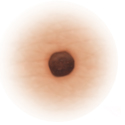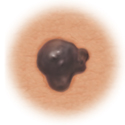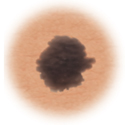Benign Skin Growths
What are benign skin growths?
Skin changes as you grow older and are exposed to sunlight, health conditions, trauma, and other environmental changes. Most people have some skin marks, such as freckles and moles. These may multiply or darken over time. Benign means they are not cancer.
What are the different types of skin growths?
Skin growth | Characteristics | Treatment |
Dermatofibromas | Small round brownish to red-purple scar-like bumps caused by a buildup of fibroblasts (soft tissue cells under the skin). They often occur on the legs and may itch. They are more common in women. | Dermatofibromas can be surgically removed if they become painful or itchy. |
Dermoid cyst | A benign tumor that is made up of hairs, sweat glands, and sebaceous (oil) glands. Some internal dermoid tumors may even contain cartilage, bone fragments, and teeth. | Dermoid cysts may be removed surgically for cosmetic reasons. |
Freckles | Darkened, flat spots that typically appear only on sun-exposed areas of the skin. Freckles are common in people with blond or red hair. | No treatment is needed for freckles. |
Keloids | Smooth, firm, raised, fibrous scars on the skin that form in wound sites. Keloids are more common in people with dark skin. | Keloids respond poorly to most treatment approaches. Injections of corticosteroid medicines may help to flatten the keloids. Other treatment approaches may include surgery, external radiation, laser treatments, or silicone patches to further flatten the keloids. |
Lipomas | Round or oval, easily movable lumps under the skin caused by fatty deposits. Lipomas tend to appear on the forearms, torso, and back of the neck. | Lipomas are generally harmless. But if the lipoma changes shape or you have symptoms, your healthcare provider may do a biopsy. Treatment of symptomatic lipomas may include surgical removal. |
Moles (nevi) | Small skin marks caused by pigment-producing cells in the skin. Moles can be flat or raised, smooth or rough, and some contain hair. Most moles are dark brown or black, but some are skin-colored or yellowish. Moles can change over time and often respond to hormonal changes. | Most moles are benign and no treatment is needed. Some benign moles may develop into skin cancer (melanoma). See below for signs. |
Atypical moles (dysplastic nevi) | Larger than normal moles (more than a half inch across), atypical moles are not always round. Atypical moles can be tan to dark brown, on a pink background. These types of moles may occur anywhere on the body. | Treatment may include removal of any atypical mole that changes in color, shape, or diameter. In addition, people with atypical moles should avoid sun exposure, since sunlight may accelerate changes in atypical moles. People with atypical moles should see a healthcare provider for any changes that may indicate skin cancer. |
Pyogenic granulomas | Red, oozing, and bleeding bump caused by excessive growth of capillaries (small blood vessels). Pyogenic granulomas usually form after an injury to the skin and bleed easily. They are common in children and pregnant women. | Some pyogenic granulomas disappear without treatment. Sometimes, a biopsy is needed to rule out cancer. Treatment may include surgical removal and electrodessication of the base. |
Seborrheic keratoses | Flesh-colored, brown, or black wart-like spots. More common in middle-aged and older people, seborrheic keratoses may be round or oval and look like they are stuck on the skin. | Usually, no treatment is needed. If the spots are irritated, or the person wants them removed for cosmetic reasons, treatment may include freezing the area with liquid nitrogen or surgery. |
Skin tags | Soft, small, flesh-colored skin flaps often seen on the neck, armpits, or groin. They are very common. | If the skin tags are irritated, or the person wants them removed for cosmetic reasons, treatment may include freezing the tags with liquid nitrogen, electrodesiccation, or surgery by cutting them off. |
Distinguishing benign moles from melanoma
Certain moles are at higher risk of changing into malignant melanoma, a form of skin cancer. Large moles that are present at birth and atypical moles have a greater chance of becoming cancerous. Finding cancerous skin growths early is important because that’s when treatment is most likely to be effective. Removing the melanoma through surgery seems to work best as the treatment. When a melanoma is diagnosed early, surgery usually removes all the cancer.
Use this ABCDE chart below to help you see changes in your moles at the earliest stages. The warning signs include:
Melanoma | Sign | Characteristic |
Asymmetry | When half of the mole does not match the other half | |
Border | When the borders (edges) of the mole are ragged or irregular | |
Color | When the color of the mole varies throughout | |
Diameter | If the mole's diameter is larger than a pencil's eraser | |
Evolving | Changes in the way the mole looks over time |







